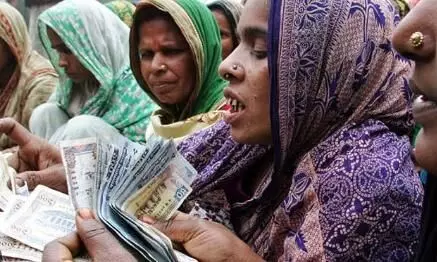
Monthly income of rural households rises 57.6 pc, financial savings up: Govt survey
text_fieldsNew Delhi: The average monthly income of rural households saw a substantial rise of 57.6 per cent over a five-year period, up from Rs 8,059 in 016-17 to Rs 12,698 in 2021-22, according to government data on Thursday.
This indicates a nominal compound annual growth rate (CAGR) of 9.5 per cent, according to the Ministry of Finance.
Annual average nominal GDP growth during the same period (on a financial year basis) was 9 per cent, according to the NABARD’s second All India Rural Financial Inclusion Survey (NAFIS) for 2021-22.
When considering all households together, the average monthly income stood at Rs 12,698, with agricultural households earning slightly more at Rs 13,661, compared to Rs 11,438 for non-agricultural households. The average monthly expenditure of rural households rose significantly from Rs 6,646 in 2016-17 to Rs 11,262 in 2021-22. The agricultural households reported a relatively higher consumption expenditure of Rs 11,710 than Rs 10,675 for non-agricultural households, as per a statement from the Ministry of Finance.
Overall, agricultural households demonstrated both higher income and expenditure levels than non-agricultural households.
According to the survey that included all 28 states and the Union Territories, salaried employment in the government or private sector was the largest income source for all households, accounting for approximately 37 per cent of their total income. For agricultural households, cultivation was the main income source, making up about one-third of their monthly earnings, followed by government or private services contributing one-fourth share, wage labour (16 per cent), and other enterprises (15 per cent).
"Among the non-agricultural ones, it was the government/private service which contributed 57 per cent of the total household income, followed by wage labour which made up for roughly 26 per cent of the total income," the survey findings noted.
When it comes to financial savings, the annual average financial savings of households increased to Rs 13,209 in 2021-22 from Rs 9,104 in 2016-17. Overall, 66 per cent of households reported saving money in 2021-22, compared to 50.6 per cent in 2016-17.
"Agricultural households outperformed non-agricultural ones in terms of savings, with 71 per cent of agricultural households reporting savings during the reference period, compared to 58 per cent of non-agricultural households," said the survey.
According to the survey, the Kisan Credit Card has emerged as a key tool for promoting financial inclusion in the rural agricultural sector, showing substantial growth in coverage over the past five years. About 44 per cent of agricultural households were found to possess a valid Kisan Credit Card (KCC), the survey noted.
IANS











